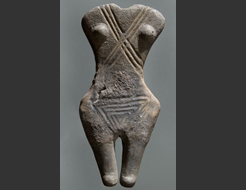|
||||||||||||||||||||||||||||||||
|
|
Museum of: Budapest | |||||||||||||||||||||||||||||||
| Name of the artefact: Headless idol (for interchangeable heads) | ||||||||||||||||||||||||||||||||
|
Unearthed from a settlement of the Baden culture.
Ritual animal burials, two contracted skeletal graves and a carved stela
were also found at this site. |
||||||||||||||||||||||||||||||||
|
WHERE IS IT AND MAIN
CHARACTERISTICS |
STATE |
|||||||||||||||||||||||||||||||
|
Department: |
Department of Prehistoric and Migration
Period |
Preservation: |
Very good | |||||||||||||||||||||||||||||
|
Inventory number: |
BTM 86.1.488. |
Restauration: |
Restored | |||||||||||||||||||||||||||||
|
Name of the artefact: |
Headless idol (for interchangeable
heads) |
Completeness: |
Complete | |||||||||||||||||||||||||||||
|
Object type: |
Human figurine |
|||||||||||||||||||||||||||||||
|
Material: |
Clay |
|||||||||||||||||||||||||||||||
|
Methof of manufacture: |
Hand made |
|||||||||||||||||||||||||||||||
|
Decoration
type: |
Incision |
|||||||||||||||||||||||||||||||
|
Distinctive mark: |
Cross-strap as symbol of
power |
|||||||||||||||||||||||||||||||
|
DIMENSIONS |
PERIOD OF USE |
|||||||||||||||||||||||||||||||
|
Length (mm): |
- |
Epoque: |
Copper Age |
|||||||||||||||||||||||||||||
|
Heigth
(mm): |
105 |
Culture: |
Baden culture |
|||||||||||||||||||||||||||||
|
Diameter
(mm): |
- |
Period: |
Late Copper Age |
|||||||||||||||||||||||||||||
|
Width (mm): |
104 |
Face: |
Classical |
|||||||||||||||||||||||||||||
|
Thickness (mm): |
38 |
Absolute chronology: |
3700-2800 BC |
|||||||||||||||||||||||||||||
|
Weight
(g): |
- |
|||||||||||||||||||||||||||||||
DISCOVERY |
||||||||||||||||||||||||||||||||
|
Date: |
1982 |
Country: |
Hungary |
|||||||||||||||||||||||||||||
|
District: |
Budapest, IV |
Town hall affiliation: |
- |
|||||||||||||||||||||||||||||
|
Village: |
- |
Discovery findspot: |
Budapest-Káposztásmegyer-Farkaserdő |
|||||||||||||||||||||||||||||
|
Condition of discovery: |
Chance Discovery |
Discovery type: |
Deposit |
|||||||||||||||||||||||||||||
|
ANALYSES – DETERMINATIONS |
FILLED IN BY |
|||||||||||||||||||||||||||||||
|
Type: |
- |
Name: |
Anna Endrődi |
|||||||||||||||||||||||||||||
|
Laboratory: |
- |
Institution: |
Budapest History Museum |
|||||||||||||||||||||||||||||
|
No./Code: |
- |
Date: |
20/10/2005 |
|||||||||||||||||||||||||||||
|
DEEPENINGS |
||||||||||||||||||||||||||||||||
|
Morphology of the object: |
||||||||||||||||||||||||||||||||
|
Showing anthropomorphic characteristics, this idol
fragment remains from the waist down to the middle of the thighs,
emphasizing the female sexual characteristics. |
||||||||||||||||||||||||||||||||
|
Decoration: |
||||||||||||||||||||||||||||||||
|
The front side of the fragment is decorated with
pressed-in parallel triangles, that emphasize the female sexual
characteristics. The rear side shows decoration made up of incised zigzag
lines. Pressed lines run along the waist of the fragment at both right and
left. |
||||||||||||||||||||||||||||||||
|
Inscription: |
||||||||||||||||||||||||||||||||
|
- |
||||||||||||||||||||||||||||||||
|
Analogies: |
||||||||||||||||||||||||||||||||
|
Analogies can be found from the Baden culture circle:
from 40 sites 91 similar objects were found. In Hungary 15 excavational
sites have yielded such artefacts; the following are examples from the
Carpathian Basin region: Budapest-Corvin tér, Aparthant (Tolna county),
Balatonöszöd (Somogy county), Esztergom (Komárom-Esztergom county).
Examples also from the Cernavodă III. culture circle where from 4 sites 18
objects have been excavated. An example from the Lower Danube region is:
Cernavodă; examples from the Southern Balkan region are which can be
connected to the early and middle phases of the Rachmani culture: Maliq,
Šuplevec, Bakarno Gumno. |
||||||||||||||||||||||||||||||||
|
Interpretation: |
||||||||||||||||||||||||||||||||
|
The main characteristics of clay figures without heads
(or interchangeable heads) are the 1 to 2, more rarely 3 deep holes where
the head should be. According to some interpretations, interchangeable
heads made of clay or wood were placed into these, but it is possible that
other organic materials, for example blades of wheat were used instead.
The statuettes are schematic, the arms are not represented, the legs are
usually closed together. The female sexual characteristics are usually
strongly emphasized by varied decorational techniques, thus the breasts
and the pubic region are depicted, the roundness of the buttocks is less
frequently portrayed, the rear side of the idols being mostly flat. A
common decoration of such clay figurines is the cross-strap running over
the breasts and back, which appear as symbols of power. A fragment of an
idol found at Tököl (Hungary) has an incised sign on its back resembling a
Mesopotamian pictogram, which could possibly refer to tattoos in use at
the time. Such headless (or interchangeable headed) idols might have stood
on the altars of domestic shrines. |
||||||||||||||||||||||||||||||||
|
Bibliography: |
||||||||||||||||||||||||||||||||
|
Endrődi, Anna Badeni idoltöredék
Káposztásmegyer-Farkaserdőről. (Badener idolfragment aus
Káposztásmegyer-Farkaserdő) Archaeologiai Értesítő 1987-1988, 81-85.
Budapest Endrődi, Anna Ein neues spätkupferzeitliches Idolbruchstück aus
Budapest (Gedanken über die Erscheinungen des religiösen Lebens)
Festschrift für Nándor Kalicz zum 75. Geburtstag 401-414. 2003. Budapest
Kalicz, Nándor Eigenartige anthropomorphe Plastik der kupferzeitlichen
Badener Kultur im Karpatenbecken- A rézkori Baden kultúra sajátságos ember
alakú plasztikája a Kárpát-medencében. Budapest Régiségei XXXVI, (Ed:
A.Endrődi-N.Kalicz)11-55. Budapest 2002. Budapesti Történeti Múzeum
Kalicz, Nándor Die Péceler (Badener) Kultur und Anatolien. StudArch II
(1963) Budapest. Bondár, Mária Neue und vergessene Idole der Badener
Kultur. ActaArchHung 51 (1999-2000) 24-34. |
||||||||||||||||||||||||||||||||

